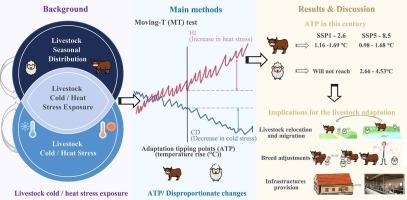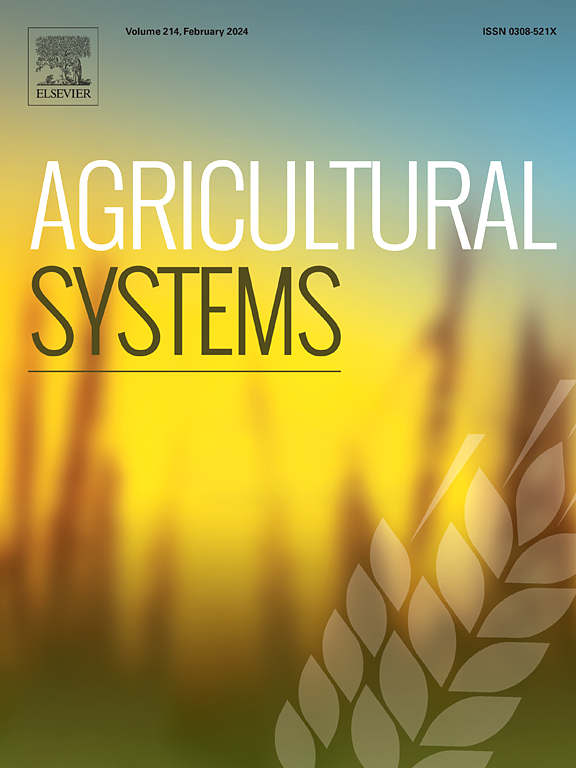Global warming creates the adaptation tipping points of livestock exposure to cold and heat stress on the Qinghai-Tibetan plateau
IF 6.1
1区 农林科学
Q1 AGRICULTURE, MULTIDISCIPLINARY
引用次数: 0
Abstract
CONTEXT
Global warming has created tipping points across various ecosystems, but few studies have focused on the livestock systems. The Qinghai-Tibetan Plateau (QTP) has been warming at a rate two to three times greater than the global average, potentially leading to a transition from historically prevalent livestock cold stress to heat stress.
OBJECTIVE
This study aims to estimate the cold and heat stress exposure of livestock systems on the QTP under climate change, and identify the adaptation tipping points and disproportionate changes of livestock predominant cold-to-heat stress exposure.
METHODS
Livestock cold and heat stress were evaluated based on seasonal distribution and specific thresholds. The Moving-t-test and non-linear analyses were used to identify adaptation tipping points and examine disproportionate changes between the increase in heat stress and the decrease in cold stress.
RESULTS AND CONCLUSIONS
The adaptation tipping points of cold-to-heat stress transition for cattle have already arrived, while that for sheep would also come within this century if warming is not limited to 2 °C. As climate warming becomes more severe, the increased heat stress exposure is greater than decreased cold stress exposure, and the positive disproportionality is increasing with the rise of temperature.
SIGNIFICANCE
This study not only sheds light on the underexplored realm of tipping points within the livestock systems but also offers crucial insights into livestock adapting to the changing dynamics of cold and heat stress on the QTP in the context of global warming.

全球变暖造成青藏高原牲畜对冷热胁迫的适应临界点
背景全球变暖已在各种生态系统中形成临界点,但很少有研究关注畜牧系统。本研究旨在估算气候变化下青藏高原畜牧系统的冷热胁迫暴露,并确定适应临界点以及畜牧系统主要冷热胁迫暴露的不成比例变化。方法根据季节分布和特定阈值评估畜牧系统的冷热胁迫。结果与结论牛从冷应激向热应激过渡的适应临界点已经到来,而羊的临界点也将在本世纪到来,如果气候变暖不限制在 2 °C。这项研究不仅揭示了家畜系统中尚未充分探索的临界点领域,而且为家畜在全球变暖背景下适应 QTP 上不断变化的冷热应激动态提供了重要见解。
本文章由计算机程序翻译,如有差异,请以英文原文为准。
求助全文
约1分钟内获得全文
求助全文
来源期刊

Agricultural Systems
农林科学-农业综合
CiteScore
13.30
自引率
7.60%
发文量
174
审稿时长
30 days
期刊介绍:
Agricultural Systems is an international journal that deals with interactions - among the components of agricultural systems, among hierarchical levels of agricultural systems, between agricultural and other land use systems, and between agricultural systems and their natural, social and economic environments.
The scope includes the development and application of systems analysis methodologies in the following areas:
Systems approaches in the sustainable intensification of agriculture; pathways for sustainable intensification; crop-livestock integration; farm-level resource allocation; quantification of benefits and trade-offs at farm to landscape levels; integrative, participatory and dynamic modelling approaches for qualitative and quantitative assessments of agricultural systems and decision making;
The interactions between agricultural and non-agricultural landscapes; the multiple services of agricultural systems; food security and the environment;
Global change and adaptation science; transformational adaptations as driven by changes in climate, policy, values and attitudes influencing the design of farming systems;
Development and application of farming systems design tools and methods for impact, scenario and case study analysis; managing the complexities of dynamic agricultural systems; innovation systems and multi stakeholder arrangements that support or promote change and (or) inform policy decisions.
 求助内容:
求助内容: 应助结果提醒方式:
应助结果提醒方式:


